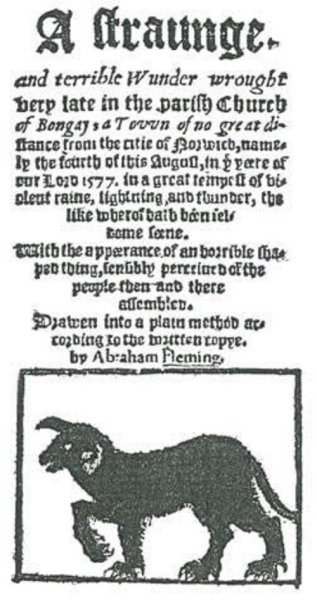MessageToEagle.com – According to folklore, Black Shuck terrorized East Anglia in 16th century. Legends speak of a giant creature with savage claws and burning eyes.
It was the hound of hell with shaggy black hair, savage claws and burning eyes.
For centuries, the beast that came to be known as Black Shuck struck fear into the hearts of all who crossed its path. Black Shuck was said to have killed worshippers in 1577.
Its most notable attack came at the Holy Trinity church in Blythburgh. During a thunderstorm, the dog came in and killed a man and a boy, leaving scorch marks on the church doors as it fled.
“All down the church in the midst of fire, the hellish monster flew, and, passing onward to the quire, he many people slew,” the legend said.
Villagers were reportedly sheltering inside the church when a huge clap of thunder caused the doors to burst open and the snarling dog crashed in.
It ran through the congregation, killing a man and a boy, before the steeple crashed through the roof.
The dog then fled, leaving scorch marks from its claws on the church door which are still visible today.
Later the same day, Black Shuck is said to have struck again 12 miles away, killing two worshippers during a service at St Mary’s Church, Bungay, while the storm was still raging.
Clergyman, the Rev Abraham Fleming, is believed to have described the appearance of the legendary hell hound in a pamphlet written in 1577, entitled ‘A Straunge and Terrible Wunder’.
He wrote: ‘This black dog, or the divel in such a linenesse (God hee knoweth al who worketh all,) running all along down the body of the church with great swiftnesse, and incredible haste, among the people, in a visible fourm and shape, passed between two persons, as they were kneeling uppon their knees, and occupied in prayer as it seemed, wrung the necks of them bothe at one instant clene backward, in somuch that even at a moment where they kneeled, they strangely dyed.’
Historian W. A. Dutt also wrote about Black Shuck in his 1901 book, Highways and Byways, set in East Anglia.
‘He takes the form of a huge black dog, and prowls along dark lanes and lonesome field footpaths, where, although his howling makes the hearer’s blood run cold, his footfalls make no sound,’ he wrote.
The legend of Black Shuck is now so popular that images of the dog have been put up in buildings across the town – and the animal is even being incorporated into Bungay’s coat of arms.
Now, during a dig, archaeologists have found remains a skeleton of a 7ft long dog among ruins at Leiston Abbey in Suffolk, UK.
According to Daily Mail, “it appears to have been buried in a shallow grave at precisely the same time as Shuck is said to have been on the loose, primarily around Suffolk and the East Anglia region.
Experts will subject the bones and surrounding material to 21st century dating techniques.
Estimates suggest it would have weighed more than 14 stone and stood 7ft tall on its hind legs.
The grave was less than 20 inches deep and unmarked. Pottery fragments found at the same level date from the height of Shuck’s alleged reign.
Radio carbon dating tests will now give an exact age for the bones, results that will serve either to enhance the shaggy dog stories – or perhaps to support the far less entertaining theory that here lies a 16th century abbot’s beloved old hunting dog”
‘The story of Black Shuck has to have originated from somewhere and, who knows, it could have originated from the dog which was buried here’, Brendon Wilkins, the excavation team said.
Pottery fragments from the 1500s were also found at the same level. Experts will now use radio carbon dating to work out the exact age of the remains.
© MessageToEagle.com







